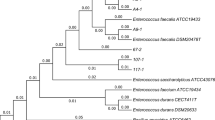Abstract
To confirm if anaerobic G+-components are those responsible for the function of colonization resistance, obligate anaerobic G+- and G−-bacteria from normal dominant microbiota of human feces were isolated from three successive collections and then used inin vitro assays for antagonism against two enteropathogenic bacteria. The production of inhibitory diffusible compounds was determined on supplemented BHI agar and MRS agar media for G−- and G+-bacteria, respectively.Salmonella enterica subsp.enterica serovar Typhimurium andShigella sonnei were used as indicators. G+-bacteria presented a higher overall antagonistic frequency against both pathogenic bacteria (57 and 64 % forS. enterica serovar Typhimurium andS. sonnei, respectively) when compared to G+-microorganisms but with a quite elevated variation between volunteers (0–100 %) and collection samples (40–72 and 40–80 % forS. enterica sv. Typhimurium andS. sonnei, respectively). On the other hand, only three among 143 G−-isolates tested showed antagonistic activity. The results showed that, at leastin vitro, obligate anaerobic G+-components of the dominant human fecal microbiota present a higher potential for antagonism against the enteropathogenic models tested than do G−-bacteria.
Similar content being viewed by others
References
Berg R.D.: The indigenous gastrointestinal microflora.Trends Microbiol.4, 430–435 (1996).
Dubos R.: The composition of the indigenous microbiota, pp. 110–128 in R. Dubos (Ed.):Man Adapting, 5th ed. Yale University Press, New Haven (USA) 1965.
Duval-Iflah Y., Raibaud P., Rousseau M.: Antagonisms among isogenic strains ofEscherichia coli in the digestive tracts of gnotobiotic mice.Infect.Immun.34, 957–969 (1981).
Farias L.M., Totola A.H., Miranda C.M.S., Carvalho M.A.R., Damasceno C.A.V., Tavares C.A.P., Cisalpino E.O., Vieira E.C.: Extraction, partial purification and characterization of a bacteriocin (fragilicin) produced by a strain of aBacteroides fragilis isolated fromCallithrix penicillata.Res.Microbiol.145, 9–16 (1994).
Freter R.: Experimental enteric shigella and vibrio infections in mice and guinea pigs.J.Exp.Med.104, 411–418 (1956).
Höhme C., Neumann D., Jentzschen M.: Antimicrobial activities of black-pigmented Gram-negative anaerobes.FEMS Immunol.Med.Microbiol.6, 235–240 (1993).
Kaper J.B., Sperandio V.: Bacterial cell-to-cell signaling in the gastrointestinal tract.Infect.Immun.73, 3197–3209 (2005).
Kozáková H., Reháková Z., Kolínská J.:Folia Microbiol.46, 573–576 (2001).
Krueger W.A., Unertl K.E.: Selective decontamination of the digestive tract.Curr.Opin.Crit.Care8, 139–144 (2002).
Lee Y.J., Yu W.K., Heo T.R.: Identification and screening for microbial activity againstClostridium difficile of Bifidobacterium andLactobacillus species isolated from healthy infant faeces.Internat.J.Antimicrob.Agents21, 340–346 (2003).
Liévin V., Peiffer I., Hudault S., Rochat F., Brassart D., Neeser J.-R., Servin A.L.:Bifidobacterium strains from resident infant human gastrointestinal microflora exert antimicrobial activity.Gut47, 646–652 (2000).
Livingston S.J., Kominossp P., Yee R.B.: New medium for selective and presumptive identification of theBacteroides fragilis group.J.Clin.Microbiol.7, 448–453 (1978).
MacCartney A.L., Wenzhi W., Tannock G.W.: Molecular analysis of the composition of the bifidobacterial andLactobacillus microflora of humans.Appl.Environ.Microbiol.62, 4608–4613 (1996).
MacFarland L.V.: Normal flora: diversity and functions.Microb.Ecol.Health Dis.12, 193–207 (2000).
Nardi R.D., Santos A.R.M., Carvalho M.A.R., Farias L.M., Benchetrit L.C., Nicoli J.R.: Antagonism against anaerobic and facultative bacteria through a diffusible inhibitory compound produced by aLactobacillus sp. isolated from rat fecal microbiota.Anaerobe5, 409–411 (1999).
Oliveira A.A.P., Farias L.M., Nicoli J.R., Costa J.E., Carvalho M.A.R.: Bacteriocin production byFusobacterium isolates recovered from the oral cavity of human subjects with and without periodontal disease and of marmosets.Res.Microbiol.149, 585–594 (1998).
Ramar F., Nicoli J.R., Dabard J., Corring T., Ladir M., Gueugneau A.-M., Raibaud P.: Trypsin-dependent production of an antibacterial substance by a humanPeptostreptococcus strain in the gnotobiotic rats andin vitro.Appl.Environ.Microbiol.59, 2876–2883 (1993).
Reuter G.: TheLactobacillus andBifidobacterium microflora of the human intestine: composition and succession.Curr.Issues Intest.Microbiol.2, 43–53 (2001).
Servin A.L.: Antagonistic activities of lactobacilli and bifidobacteria against microbial pathogens.FEMS Microbiol.Rev.28, 405–440 (2004).
Silva S.H., Vieira E.C., Nicoli J.R.: Antagonism againstVibrio cholerae by bacterial diffusible compound in the fecal microbiota of rodents.Rev.Microbiol.29, 228–233 (1998).
Silva S.H., Vieira E.C., Dias R.S., Nicoli J.R.: Antagonism againstVibrio cholerae by diffusible substances produced by bacterial components of the human faecal microbiota.J.Med.Microbiol.50, 161–164 (2001).
Sullivan D.J.O.: Screening of intestinal microflora for effective probiotic bacteria.J.Agric.Food Chem.49, 1751–1760 (2001).
Tannock G.W., Tilsala-Timisjarvi A., Rodtong S., Ng J., Munro K., Alatossava T.: Identification ofLactobacillus isolates from the gastrointestinal tract, silage, and yoghurt by 16S–26S rRNA gene intergenic spacer region sequence comparisons.Appl.Environ.Microbiol.65, 4264–4267 (1999).
Teitelbaum J.E., Walker W.A.: Nutritional impact of pre- and probiotics as protective gastrointestinal organisms.Ann.Rev.Nutr.22, 107–138 (2002).
Toure R., Kheadr E., Lacroix C., Moroni O., Fliss I.: Production of antibacterial substances by bifidobacterial isolates form infant stool active againstListeria monocytogenes.J.Appl.Microbiol.95, 1058–1069 (2003).
Van der Waaij D.: Colonization pattern of the digestive tract by potentially pathogenic microorganisms: colonization-controlling mechanisms and consequences for antibiotic treatment.Infection11, S90-S92 (1983).
Vlková E., Rada V., Bujňáková D., Kmeť V.: Enumeration, isolation, and identification of bifidobacteria from infant feces.Folia Microbiol.49, 209–212 (2004).
Zoetendal E.G., Akkermans A.D., de Vos W.M.: Temperature gradient gel electrophoresis analysis of 16S rRNA from human fecal samples reveals stable and host-specific communities of active bacteria.Appl.Environ.Microbiol.64, 3854–3859 (1998).
Author information
Authors and Affiliations
Corresponding author
Additional information
This work was supported by grants fromConselho Nacional de Desenvolvimento Cientifico e Tecnologico (CNPq),Fundação de Amparo à Pesquisa do Estado de Minas Gerais (FAPEMIG) andCoordenação de Aperfeiçoamento de Pessoal de Nivel Superior (CAPES).
Rights and permissions
About this article
Cite this article
Gomes, D.A., Souza, A.M.L., Lopes, R.V. et al. Comparison of antagonistic ability against enteropathogens by G+ and G− anaerobic dominant components of human fecal microbiota. Folia Microbiol 51, 141–145 (2006). https://doi.org/10.1007/BF02932170
Received:
Revised:
Issue Date:
DOI: https://doi.org/10.1007/BF02932170




